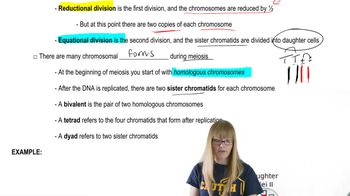If the cross described in Problem 18 were made, and if Sb and cu are 8.2 map units apart on chromosome III, and if 1000 offspring were recovered, what would be the outcome of the cross, assuming that equal numbers of males and females were observed?
Table of contents
- 1. Introduction to Genetics51m
- 2. Mendel's Laws of Inheritance3h 37m
- 3. Extensions to Mendelian Inheritance2h 41m
- 4. Genetic Mapping and Linkage2h 28m
- 5. Genetics of Bacteria and Viruses1h 21m
- 6. Chromosomal Variation1h 48m
- 7. DNA and Chromosome Structure56m
- 8. DNA Replication1h 10m
- 9. Mitosis and Meiosis1h 34m
- 10. Transcription1h 0m
- 11. Translation58m
- 12. Gene Regulation in Prokaryotes1h 19m
- 13. Gene Regulation in Eukaryotes44m
- 14. Genetic Control of Development44m
- 15. Genomes and Genomics1h 50m
- 16. Transposable Elements47m
- 17. Mutation, Repair, and Recombination1h 6m
- 18. Molecular Genetic Tools19m
- 19. Cancer Genetics29m
- 20. Quantitative Genetics1h 26m
- 21. Population Genetics50m
- 22. Evolutionary Genetics29m
4. Genetic Mapping and Linkage
Crossing Over and Recombinants
Problem 21
Textbook Question
What possible conclusions can be drawn from the observations that in male Drosophila, no crossing over occurs, and that during meiosis, synaptonemal complexes are not seen in males but are observed in females where crossing over occurs?
 Verified step by step guidance
Verified step by step guidance1
Understand the role of crossing over: Crossing over is a process during meiosis where homologous chromosomes exchange genetic material. This typically occurs during prophase I and is facilitated by the formation of synaptonemal complexes, which are protein structures that align homologous chromosomes closely together.
Analyze the observation in male Drosophila: The absence of crossing over in male Drosophila suggests that homologous chromosomes do not exchange genetic material during meiosis. This is a unique feature of male Drosophila meiosis compared to many other organisms.
Relate the absence of synaptonemal complexes to crossing over: Synaptonemal complexes are essential for facilitating crossing over. The observation that these complexes are not present in male Drosophila meiosis supports the conclusion that crossing over does not occur in males.
Compare male and female meiosis in Drosophila: In female Drosophila, synaptonemal complexes are observed, and crossing over occurs. This indicates that the mechanisms of meiosis differ between males and females, with females utilizing crossing over for genetic recombination while males do not.
Conclude the biological significance: The lack of crossing over in male Drosophila meiosis may be an evolutionary adaptation. It could simplify the process of gamete formation in males or reflect a different strategy for maintaining genetic stability in male gametes.
 Verified video answer for a similar problem:
Verified video answer for a similar problem:This video solution was recommended by our tutors as helpful for the problem above
Video duration:
1mPlay a video:
Was this helpful?
Key Concepts
Here are the essential concepts you must grasp in order to answer the question correctly.
Crossing Over
Crossing over is a genetic process that occurs during meiosis, where homologous chromosomes exchange segments of genetic material. This process increases genetic diversity in gametes. In Drosophila, the absence of crossing over in males suggests a difference in meiotic behavior between sexes, impacting genetic variation.
Recommended video:
Guided course

Discovery of Crossing Over
Meiosis
Meiosis is a specialized type of cell division that reduces the chromosome number by half, resulting in the formation of gametes. It consists of two rounds of division: meiosis I and meiosis II. The presence or absence of synaptonemal complexes during meiosis indicates the pairing and recombination of chromosomes, which is crucial for genetic diversity.
Recommended video:
Guided course

Meiosis Overview
Synaptonemal Complex
The synaptonemal complex is a protein structure that forms between homologous chromosomes during meiosis, facilitating their alignment and recombination. Its presence in female Drosophila indicates that crossing over occurs, while its absence in males suggests a different meiotic mechanism, leading to implications for genetic inheritance and variation in these organisms.
Recommended video:
Guided course

Arabinose Operon
Related Videos
Related Practice
Textbook Question
475
views


